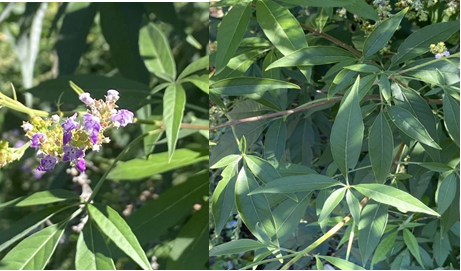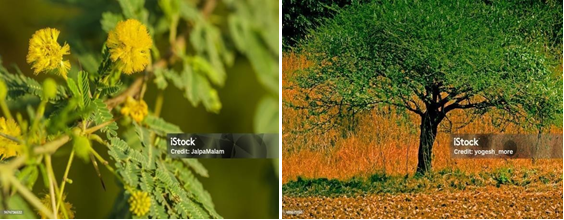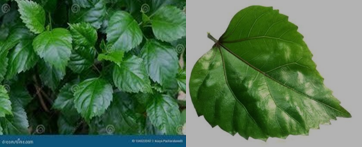The antifungal properties of medicinal plants Vitex negundo, Acacia nilotica, and Hibiscus rosa-sinensis were evaluated for their potential to combat fungal infections. Vitex negundo demonstrated significant antifungal activity against common pathogenic fungi due to its rich phytochemical composition, including flavonoids and alkaloids. Acacia nilotica exhibited notable antifungal effects, particularly against dermatophytes and yeasts, owing to the presence of tannins and saponins. Hibiscus rosa-sinensis showed promising antifungal properties as well, attributed to its anthocyanin and flavonoid content. The results suggest that these plants could serve as potential sources of natural antifungal agents, offering a sustainable alternative to synthetic antifungal drugs. Further studies are required to isolate the active compounds and evaluate their mechanisms of action.
Antifungal Property, medicinal plants, Hibiscus Rosa Sinesin
Aspergillosis, dermatophytosis, systemic mycoses, and candidiasis are among the fungal infections that have become a serious global health concern. The use of broad-spectrum antibiotics, immune-suppression, and an increase in the number of people with weakened immune systems have all contributed to the growth in the prevalence of fungal infections.[1] As a result, the increase in antifungal resistance has high-lighted how urgent it is to identify substitute and efficient treatment approaches. For millennia, traditional medicine has employed medicinal plants to treat a variety of illnesses, including fungal infections. Research are interested in investigating these plants' potential as natural antifungal medicines because of the wide variety of bioactive chemicals they contain.[2] In order to shed light on the mechanisms of action and possible clinical applications of medicinal plants' antifungal activities, this thorough study attempts to compile and evaluate the most recent scientific data[3].
Humans and the microorganisms around them coexist peacefully, but when an immune system is compromised or the pathogen concentration reaches an unusually high density, an infection may arise from the microorganisms; on the other hand, infectious disease refers to a condition in which the infecting agents docause the body to react, resulting in signs and symptoms that are clinically manifest. In factions diseases can arise from a variety of sources, including bacteria, viruses, parasites, fungus, prions, worms, and helminths. A few decades ago, the most dreaded infection was one brought on by bacteria. However, as patient management techniques for bacterial infections advanced, fungi emerged as the most dangerous pathogens.[4] A main or secondary infection brought on by the Candida species is called candidiasis.[5] The mouth, throat, skin, vagina, fingers, nails, trachea, lung, or gastro-intestinal system may be the only areas where an infection occurs. Candida species can induce invasive candidiasis (IC), which includes deep-seated tissue infections and blood-derived infections (candidemia), when there is significant immune system impairment.[6–7] Over the past three decades, antimicrobial agent resistance has grown to be a global issue. Every year, Almost 2 million Americans contract bacterial and fungal infections; ofthese,65% of patients are drug- resistant. [8–9] Around 3,000,000, 250,000, 700,000, and 223, 100 cases of invasive aspergillosis, invasive candidiasis, and cryptococcal mening it is among AIDS patients have been reported globally in recent estimates.[10]
METHOD
A thorough search of the literature was carried out utilizing reliable academic data bases such as We b of Science, PubMed, and Scopus. Among the search terms were "antifungal," "phytochemicals," "medicinal plants," and "mechanism of action." To guarantee the inclusion of current knowledge, only peer-reviewed publications released between 2010 and 2023 were taken into consideration.
Investigating medicinal plants' antifungal effectiveness against different fungal infections was the main goal of the chosen studies. To evaluate there liability of there sults, the study's methods—such as animal models, time-kill assays, and minimum inhibitory concentration (MIC) assays—were also look edat.
Medicinal Plant And Their Antifungal Properties
A medicinal plant in this review has a detailed description that includes information on its constituents (Table 1) and antifungal qualities.
Vitex Negundo (Nirgundi)
Growing to as mall tree, Vitex negundo Linn. Belonging to family Verbenaceae is a fragrant, woody shrub. It typically has quadrangular branches with tri-or penta-foliate leaves, which give birth to bluish-purple flowers in branched to men to secymes. It is found in wastelands, mixed open forests, Afghanistan, India, Pakistan, Sri-Lanka, Thailand, Malaysia, eastern Africa, and Madagascar. It grows best in humid environments or be side water channels. Certain regions of Asia, Europe, North America, and the West Indies cultivate it for commercial purposes.[11]
Synonym of plant in Sanskrit: Indrani, Nilani gundi, Nila Pushpa, Nir gundi, Nirgundika, Renuka, Sephalika, Shephali, Shvetasurasa, Sindhooka, Sindhuvaram. In Hindi: Mewri, Nengar, Ningori, Nirgandi, Nirgunda, Nisinda, Panikisambhalu, Sambhal, Sambhalu, Nirgundi, Shimalu. Urdu: Sambhalu, Tukhmsambhalu. Bengali Nisinda, Sinduari, Beguna, Nishinda, Nishinde. In Kannada: Bile-nekki,
Bilenekki, Karilakki, Lakkagida, Lakki, Lakki-gida, Lakkili. In Malyalam: Bem- nosi, Indrani, Karunocci, Noch-chi, Nochi, Vella-noch-chi. In Marathi: Nirgunda, Nengar, Nirgur, Lingur, Nirguda, Nirgundi, Limgud, Negumd. In Oriya: Thingkhawilupa, Niligundi. In Tamil: Nallanocci, Nirkkundi, Nirkundi, Nochi, Sinduvaram, Tiriburamerittan. In Telgu: Nalla-vavili, Nallavavili, Sindhuvaruma, Sinduvaramu, Tell-vavili.[12] The subkingdom is Tracheobionta–Vascularplants, the Super division is Spermatophyte–Seed plants, the Division is Magnoliophyta–Flowering plants, the Classs is Magnoliopsida – Dicotyledons, the Subclass is Asteridae, the Order is Lamiales, the Family is Verbenaceae – Verbena. The Genus is Vitex Linn and the Species Is Panjghust (vitexnegundo) Linn.[13] The Botanical description of Vitex negundo is a deciduous shrub that grows to a small tree and is scented and woody. Monk's pepper or the five-leafed chaste tree are other names for Vitex negundo. Its mos tremarkable characteristicis a group of five palm- like, pointy leaves. The tree is tall, 2–5 m, slender, and has branchletsthat are quadrangular in shape. Five leaflets, lanceolate, sharp, glabarous, 4–10cm long, hairy underneath, and pointy at both ends, are palmately arranged in the leaves. The petioles of the lateral leaflets are small, while those of the terminal leaflet are long. The up to30-cm-long axillary or terminal panicle has bluish-purple flowers. When ripe, the fruit is a succulent, globose black fruit with four spherical, 4mm-diameter seeds.[14] The effect of vitex negundo inn. In different pathogen and pests is as follows they act as antibacterial activity and their action against bacteria: Escherichia coli, Proteus vulgarism, Klebsiella aero genes, and Pseudomonas aero genes. They act as anti-feedant activity and their action against Achoeajanata ( Castor semi-looper), and Spodopteralitura (Asian army-worm). The act as anti-filarial activity and they act against Brugiamalayi, a parasitic micro filarial. They most comnaly used as anti- fungal activity and they act against Curvular alunata and Alteernaria alternate candida albicans, Aspergillus Niger, Cryptococcus neoformans, and Trichophytonentagrophytes. They act as Insecticidal activity and their action ispulse beetle, Callosobruchusmacularatus. The potato-tuber moth, PhthorimaeaoperculellaSitotrogacerealella( Grain moth of Angoumois ) Aphis gossypii (thecottonormelons aphid), Aphiscitricola( thespiriteaphid) and Myzuspersicae(thegreenpeachaphid).Then they act as Larvicidal activity and they act against Anophelessubpictus, Culexquinquefaciatus, Culeztritaeniorhynchusm and Anopheles step hensiarethemospuito species. The diamond-backmoth, plutellaxylostella. Plasmodium falciparum, Cnaphalocrocismedinalis (riceleaf- folder ), then they show the activity of Mosquito repellent and the act against Culextritaeniorhynchus, Aedesaegypti (Mosquito)[15]
Photo of vitex negundo leaves.

Figure 1 . vitex negundo leaves.
Extraction process of vitex negundo leaves is the leaves were divided, thoroughly cleaned to getridof any unnecessary material, dried in the shade, and then blended into a powder. Each leaf material weighed around 25g, and it was extracted using methanol in a Soxhlet device. Them ethanol extracts were dried in a desiccator, concentrated in a vacuum at low pressure, and filtered through Whatman No.1.[16] The phytochemical found in vitex negundo is alkaloids, flavonoids, terpenoids, tannins, saponins, glycosides, and sterols—the extracts of Vnvnand Vnvp were screened phytochemically.[17] and the chemical constituent was found to be Hexamethyl-3,6,7,3?,4?-pentamethoxy flavone from leaves [18] Two types of mussaenosidicacidare6?-p-hydroxy benzoyl and2?-p-hydroxy benzoyl. [19–20]
?-caryophyllene, sabinene, 4-terpineol, gamma-terpinene, caryophyllene oxide,5, 3?-dihydroxy-7,8,4?-trimethoxyflavanone; 5,3?-dihydroxy-6,7,4?-trimethoxy flavanone.[21]viridiflorol;1-oceten-3-ol;globulol.[22]ursolicacid[2?- hydroxyurs12-en-28-oicacid];betulinicacid [3?-hydroxylup-20-(29)-en-28- oicacid] n-
hentriacontanol; ?-sitosterol; p hydroxy benzoic acid.[23]protocatechuic acid; oleanolic acid; flavonoids.[24] angusid; casticin; vitamin-C; nishindine; gluco-nonitol; p-hydroxy benzoic acid; sitosterol.[25]
The atctive chemical constituent present in Vitex negundo, commonly known as five-leaved chaste tree, contains several active compounds that exhibit antifungal properties. One of the key constituents is “caryophyllene”, as esquiterpene known for its antifungal activity. Additionally, other compounds like flavonoids and essential oils in Vitex negundo may also contribute to its antifungal effects. These compounds work together to provide a range of medicinal properties, including antifungal activity.[26]
Acacia Nilotica (Babhul)
Plants have great significance due to their nutritive value and are also a major source of medicines. Plants have served mankind through-out the history of human civilization.[27] Acacia nilotica also known as gum Arabic, Egyptian thornin Egypt, scanted tree in English, thorn in mimosa in Australia and commonly known as “Bagaruwa” among the Hausas, isaspecies of vachellia and agenus of Acacia. It is a thorny Acacia found in different parts of the world (West Asia, Africa, Eastwards India, Australia).[28] Acacia nilotica L. (gum arabic, babul, Egyptian thorn, thorn mimosa or scented thorn in South Africa) is a species of Acacia native to Africa and the Indian subcontinent. The ethanolic extract of Acacia nilotica (L.) stem exhibit are mark able hypoglycemic activity. Screening of the different organs of Acacia nilotica (L.) revealed the presence of tannins, saponins, coumarins, carbohydrates and/or glycosides, un satd. Sterol, triterpenes, alkaloids and nitrogenous bases, flavonoids and cyanogenic compounds.[29]The herb Acacia Nilotica is commonly utilized in traditional medicine. Nearly every part of them, including the root,bark, leaves, flowers, gums, and pods, is utilized in medicine.[30] This herb possesses antibacterial, anti-plasmodial, anticancer, antimutagenic, and antioxidant properties. It is used to treat piles, hepatitis C virus, burns, scalds, and cough, sorethroat, diarrhea, dysentery, and tuberculosis.[31]
They nonyms is Acacia arabica(Lam.) Willd. Mimosa arabica Lam. Mimosa nilotica Linn. English Name is Babul, Black Babul, Indian, Gum arabic tree. Ayurvedic name is Babbuula, Babbuuri, Baavari, Aabhaa, Shuulikaa, Shitaka,
Kinkiraata, Yugmakantaka, Sukshmapatra, Pitapushpaka. The unani is Aqaaqia, Babuul, Kikar, Mughilaan, Samur. The siddha / tamil is Karu-velamaram, Karuvelei. Velampisin (gum). [32] The taxonomical classification is as follows the subkingdom is tracheoionta, the super division is spermatophyta, the division is magnoliophyta, the classis magnoliopsida, the sub class is rosidae, the order is fabales, the family is fabaceae, the genus is acacia and the species is nilotica.[33]
The phytochemical present in the leaves through phytochemical screening of ethanolic extracts, tannins, alkaloids, and sterols were found in Acacia nilotica leaves; glycosides, saponins, resins, and flavonoids were not found. Additionally, alkaloids, saponins, cardiac glycosides, tannins, and flavonoids were shown by MrityunjoyDasETal.[34]Tannins: These poly phenolic substances are well known for having antibacterial and antioxidant qualities.[35]
Medicinal use of all part of acacia nilotica plant is the root are used against cancers and/or tumors (of ear, eye, or testicles), tuberculosis and indurations of liver and spleen.[40] The leaf is chemo-prventive anitmutagenic, anti bacterial, anticancer, astringent, anti microbial activity Tender leaves are used to treat diarrhea, Aphrodisiac, dressing of ulcers, anti-inflammatory and Alzheimer’s diseases.[41] The gum are astringent, emollient, liver tonic, antipyretic and antiasthmatic.[42] The steam bark are anti bacterial, antioxidant, anti-mutagenic, cytotoxic bark isused as astringent, acrid cooling, styptic, emollient, an the lmintic, aphrodisiac, diuretic, expectorant, emetic, nutritive, in hemorrhage, wound ulcers, leprosy, leucoderma, small pox, skin diseases, biliousness, burning sensation, toothache, leucoderma, dysentery and seminal weakness. The trunk bark is used for cold, bronchitis, diarrhoea, dysentery, biliousness, bleeding piles and leucoderma.[43] The seed is Spasmogenic activity and antiplasmodial activity.[44] and the pods are act as anti hypertensive and antispasmodic, anti-diarrhoerial, astringent, anti-fertility and against HIV-1 PR, Inhibited HIV-1 induced cythopathogenicity, antiplatelet aggregatory activity and antioxidant.[45] Antifungal and antiviral activity of Acacia nilotica species can be regarded as promising resources for antibacterial drugs due to its highly active nature. Have showed antifungal activity of methanolic extracts and aqueous extract of Acacia nilotica with percentage inhibition ranging from 34.27± 1.45to93.35±1.99(14,15). Dried fruits of Acacia nilotica are active against C. albicans and used to treat oral candidiasis. Methanolic extract of the plant is active against two animal viruses: New castle Disease and Fow l pox Viruses.[46] Active chemical constituent act against fungal infection is Tannins these polyphenolic compounds can inhibit fungal growth and disrupt cell walls.[48] Flavonoid these compounds such as quercetin and kaempferol have demonstrated antifungal properties against various fungi.[49] Saponins these can disrupt fungal cell membranes, leading to cell lysis . Alkaloids they some alkaloids found in the plant may exhibit antifungal effects.[50] The essential oils is compounds like eugenol may also contribute to antifungal activity.[51] Pharmacological use of acacia nilotica are high antibacterial activity against Staphylococcus aureus, Escherichiacoli, Proteusvulgaris, Proteusmirabilis, SalmonellaparatyphiB, Klebsiellapneumoniad etected by D eshpande SN.[47]
Hibiscus Rosa-Sinesis
Hibiscus rosa-sinensis is a flowering plant that belongs to the Malvaceae family, also known as the "mallows," which is valued for its medicinal properties and herbal tea. It is a showy, evergreen, woody shrub that reaches a height of approximately 5 to 8 feet and is smooth in texture. It is widely grown as an ornamental plant in tropical settings, both at home and in public spaces. For medicinal trust, the red-flowered type is more favored.[52-53] Many nations, including Egypt, China, Ethiopia, Syria, Southern Iraq, and central and western Sudan, farm the plant extensively. They flourish in pleasantly warm conditions that witness the herbal plant’s broad proliferation in the southern Mediterranean and the tropics, including the horn of Africa. Additional research has demonstrated the several health advantages of Hibiscus rosa-sinensis. For instance, drinking hibiscus tea reduces high blood pressure, speeds up blood circulation (which lowers blood pressure in a group of individuals who are pre-hypertensive and mildly hypertensive), and fortifies the heart.[54] One of the most exquisite shrub stop lantin tropical and sub tropical gardens is the hibiscus. It is refer red to by the colloquial names Rudrapushpa, Sthalpaddo, Bettada Tavare, and Dasala. It is also known as the Queen of Tropics. Commonly known as Chinese hibiscus, Rose of China, Hawaiian hibiscus, Blacking plant, or Shoe flower, it is a flowering plant that growsin hot, temperate climates. The world's leading hub for hibiscus cultivation is Florida. Through successful breeding efforts, the American Hibiscus Society contributes to the evolution of valuable innovations.[55] Simple oblong or ovate- lanceolate leaves with coarse teeth at the tip are present. Flowers are composed of five red petals and have pedicels. The young leaves are said to have medicinal properties and are frequently eaten as a vegetable in the Nigerian state of AkwaIbom. Because Hibiscus rosa-sinensis has special chemical components that are biologically active, it has had a significant impact on human health [56]. More than half of all clinical drugs used today have natural product origins. Hibiscus has long Been used as an analgesic, anti-inflammatory, anti-tumor, anti-asthmatic, anti- pyretic, and anti-convulsant.[57] The Synonyms of hibiscus rosa-sinesis is Hibiscus arnottii Griff. ex Mast.; Hibiscus boryanus DC.; Hibiscus cooperiauct.; Hibiscus festalisSalisb., Hibiscus liliiflorus Griff. exMast., Hibiscus rosiflorus Stokes and Hibiscus storcki iSeem.[58] The subkingdom is Tracheobionta, the Super divisionis Spermatophyta, the Division is Magnoliophyta, the Class is Magnoliopsida, the Subclass is Dilleniidae, the Order is Malvales, the Family is Malvaceae the Genus is Hibiscus and the Species is Hibiscus rosa-sinensis.[59] The botanical description is Hibiscus rosa-sinensis is an evergreen, woody, glabrous, showy shrub that grows to a height of 5-8 feet, according to S. Verma.The leaves are lanceolate or ovate, short petiolated, bright green, and about acuminate. They are also subulate, glabrous, and have a few tiny stellate hair son the nerves behind the stipules. The leaves are also irregularly and coarse lyser rated towards the top, entire toward the base, and glabrous on both sides. Pedicels are united above the middle, axillary, solitary, and longer than the leaves. Large, solitary, axillary, bisexual flowers with five petals form a bell shape. The pistil is red, and orange stamens protrude from the center of the flower. In the original types, the blossoms are usually crimson but usually smell nothing. In addition, a wide selection of colors— including white, yellow, orange, red, pink, purple, and soon—are offered in single, double, or multiple tones.[60] Phytochemical constituent of hibiscusrosa-sinesesis as follows Research on Hibiscus rosa sinensis is extensive. According to the report, it includes total phenols, total proanthocyanidin, total flavonoids, tannins, steroids, alkaloids, and saponins. Additionally, it has been observed to include primarily quercetin3,7- diglucoside, quercetin-3-diglucoside, anthocyanins and flavonoids, and cynidin-3- sophoroside-5-glucoside. In addition, additional substances such as quercetin, hentriacontane, cyaniding chloride, cyclopeptide alkaloid, and vitamins (thiamine and ascorbic acid) are found. Sterols, sugars, glycosides, tannins, triterpenoids, saponins, mucilage, and flavonoids are all present in the root so fH.sinensis. Cyaniding diglucoside, flavonoids, vitamins, thiamine, riboflavin, niacin, and scorbic acid are all present in hibiscus flowers. H.rosasinensis extract is a source of numerous potentially beneficial antioxidant sand anticancer elements such as quercetin, glycosides, riboflavin, niacin, carotene, malvalic acid gentisic acid, margaric acidc and lauric acid[61]


 Vaibhav Paymal*
Vaibhav Paymal*









 10.5281/zenodo.14236610
10.5281/zenodo.14236610